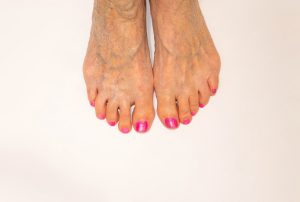
What causes poor circulation in feet
Poor blood circulation has been linked to chronic health conditions such has high blood pressure, obesity, and diabetes. The following are some of the most recognized causes of poor circulation in feet:
- Peripheral artery disease: This is a condition where distant arteries aren’t able to receive normal adequate blood flow due to narrowing vessels. This condition can cause tingling, numbness, nerve, and tissue damage over time. When the veins are affected, a condition called venous insufficiency occurs, resulting in ineffective delivery of blood back to the heart from the legs. Venous insufficiency can lead to varicose veins, severe leg swelling, and skin discoloration. A condition called atherosclerosis, which results in blood vessel stiffening due to plaque buildup, is often associated with peripheral artery disease.
- Blood clots: When the body experiences abnormal blood clotting, clots can obstruct blood vessels. If a blood clot occurs in the legs, it can lead to pain and discoloration. This is known as deep vein thrombosis (DVT), and it has the potential to dislodge and travel to the lungs.
- Varicose veins: Due to the incompetence of the valves in the veins. This means that insufficient blood flow occurs, leading to poor circulation. This condition is commonly seen in overweight women.
- Diabetes: This is a condition signified by poor blood sugar metabolism and leads to poor blood circulation long term. Diabetic patients will often complain of cramping pain in the legs, calves, thighs, and buttocks, especially during times of activity. Over time, a condition called diabetic neuropathy may develop, leading to decreased sensation in the extremities. Diabetics also have many problems with atherosclerosis, high blood pressure, and heart disease.
- Raynaud’s disease: This is a condition that causes the small arteries in the hands and toes to narrow, leading to you to experience chronically cold hands and feet. These narrow vessels make it difficult for blood to pass through, leading to poor circulation. Individuals with Raynaud’s disease commonly present with symptoms when exposed to cold temperatures or during times of stress. These symptoms may also be seen in the lips, nose, nipples, and ears. The condition is more commonly seen in women who live in colder climate areas.
Symptoms of poor circulation in feet
Having poor circulation in feet usually indicates that another underlying condition exists. Considering that there are many underlying conditions that lead to poor circulation in feet, each has unique symptoms. However, poor circulation commonly has the following signs and symptoms:
- Leg numbness or weakness
- Poor wound healing or an ulcer on the toe, foot, or leg
- Loss of hair on the legs or slower hair growth on the legs
- Skin of the legs appears shiny or has a change of color
- Weak or no pulse in the legs or feet
- Painful cramping of the hip, thigh, or calf muscles after activity
- Legs or feet getting colder much more quickly than other parts of the body
- Slower toenail growth
- Erectile dysfunction
Poor circulation in feet treatment
Management of underlying conditions leading to symptoms of poor circulation in the feet is the best form of treatment. This includes properly treating your atherosclerosis or diabetes with the guidance of a trained medical professional. However, there are some things you can do on your own that can help improve poor circulation in feet
- Avoid sitting for too long: Standing up from time to time improves circulation. Much of today’s society is living a sedentary lifestyle. Getting in a short walk will contract leg muscles and promote blood circulation.
- Exercise: Nothing gets the heart pumping like exercise. Great exercises include walking, biking, running, swimming, and hiking. Low impact exercises are good too, like yoga. As long as you keep your body moving, you will benefit from good circulation.
- Wear comfortable shoes: Tight fitting shoes like heels can impede blood flow. Wearing a low heel with proper cushioning will help you stay moving.
- Quit smoking: This bad habit is known for increasing your risk of peripheral artery disease along with a whole slew of other potentially fatal health conditions. Quitting smoking will help improve blood flow in a matter of weeks.
- Restrict salt intake: Excess salt in the diet can lead to water retention and leg swelling. This puts pressure on your veins, leading to poor circulation. High salt is commonly found in processed foods, fast foods, and junk food. Staying hydrated helps promote blood circulation as well.
- Lose weight: Maintaining a healthy body weight helps keep your body healthy and your circulatory system working efficiently.
- Gingko supplements: A commonly used herbal medication known for opening blood vessels promoting blood circulation. Recommended doses range from 120-240mg/day.
Related: Poor circulation treatment: How to improve blood circulation